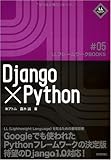「Django 最初のアプリケーション 4」の版間の差分
ナビゲーションに移動
検索に移動
| 1行目: | 1行目: | ||
| − | ==Django 最初のアプリケーション 4== | + | ==[[Django 最初のアプリケーション 4]]== |
| − | + | [Django][Python][[Django 最初のアプリケーション 3]|[前]] | |
| − | + | [[Python]]の概要も分かり易い. | |
{{amazon|477413760X}} | {{amazon|477413760X}} | ||
| 8行目: | 8行目: | ||
*SVN release http://docs.djangoproject.com/en/dev/intro/tutorial04/ | *SVN release http://docs.djangoproject.com/en/dev/intro/tutorial04/ | ||
| − | *Django 1.0 http://docs.djangoproject.com/en/1.0/intro/tutorial04/ | + | *[[Django]] 1.0 http://docs.djangoproject.com/en/1.0/intro/tutorial04/ |
| − | Django 1.0を参考にサンプルアプリケーションを作成してみる | + | [[Django]] 1.0を参考にサンプルアプリケーションを作成してみる |
===シンプルなフォームの作成=== | ===シンプルなフォームの作成=== | ||
| 24行目: | 24行目: | ||
*ラジオボタンは、Choide IDと結び付けられており、名前は "choice"。選択して、サブミットしたときには、POSTデータは choice=3 のようになる。 | *ラジオボタンは、Choide IDと結び付けられており、名前は "choice"。選択して、サブミットしたときには、POSTデータは choice=3 のようになる。 | ||
| − | *Formエレメントのactionに /polls/{{ poll.id }}/vote/ とし、method="post" | + | *Formエレメントのactionに /polls/{{ poll.id }}/vote/ とし、method="post"としたが、これは[[Django]]に限らず、Web開発では重要。 |
*fooloop.counter は、何回ループカウンタが回ったかをあらわす | *fooloop.counter は、何回ループカウンタが回ったかをあらわす | ||
===投票ビュー、結果表示ビューの作成=== | ===投票ビュー、結果表示ビューの作成=== | ||
| − | *Django 最初のアプリケーション | + | *[[Django 最初のアプリケーション 3]]を思い出して、Voteビューを作成する |
*mysite/polls/urls.py には、以下のように記述していた | *mysite/polls/urls.py には、以下のように記述していた | ||
| 34行目: | 34行目: | ||
====vote()、results()関数の記述==== | ====vote()、results()関数の記述==== | ||
| − | *mysite/polls/ | + | *mysite/polls/[[vi]]ews.py にvote()、results()関数を記述する |
# -*- coding: utf-8 -*- | # -*- coding: utf-8 -*- | ||
from django.shortcuts import render_to_response, get_object_or_404 | from django.shortcuts import render_to_response, get_object_or_404 | ||
| − | from django.http import | + | from django.http import Http[[R]]esponse[[R]]edirect |
from django.core.urlresolvers import reverse | from django.core.urlresolvers import reverse | ||
from mysite.polls.models import Choice, Poll | from mysite.polls.models import Choice, Poll | ||
| 62行目: | 62行目: | ||
selected_choice.votes +=1 | selected_choice.votes +=1 | ||
selected_choice.save() | selected_choice.save() | ||
| − | # | + | # 処理成功後は常にPOSTデータとともにHttp[[R]]esponse[[R]]edirectを返す |
# これはユーザの2度押しによる再送信を防止する | # これはユーザの2度押しによる再送信を防止する | ||
| − | return HttpResponseRedirect(reverse('mysite.polls. | + | return HttpResponseRedirect(reverse('mysite.polls.[[vi]]ews.results', args=(p.id,))) |
def results(request, poll_id): | def results(request, poll_id): | ||
| 73行目: | 73行目: | ||
*request.POST はディクショナリのようなオブジェクトで、サブミットされたデータをキーにより取得できる。上記の例では、request.POST['choice'] で、選択されたChoiceを文字列として取得できる | *request.POST はディクショナリのようなオブジェクトで、サブミットされたデータをキーにより取得できる。上記の例では、request.POST['choice'] で、選択されたChoiceを文字列として取得できる | ||
*request.POSTの値は常に文字列 | *request.POSTの値は常に文字列 | ||
| − | * | + | *[[Django]]は同様に、request.GETも提供する。 |
*POSTデータとして送信されてこない場合、request.POST['choice'] は KeyErrorを引き起こす。 | *POSTデータとして送信されてこない場合、request.POST['choice'] は KeyErrorを引き起こす。 | ||
| − | ===== | + | =====Http[[R]]esponse[[R]]edirect===== |
| − | * | + | *Choiceのカウントをインクリメントした後、Http[[R]]esponseではなく、コードのコメントにある理由から、Http[[R]]esponse[[R]]edirectを返すほうがよい。Http[[R]]esponse[[R]]edirectはリダイレクト先のU[[R]]Lを引数として1つ取る。 |
=====reverse()===== | =====reverse()===== | ||
| − | * | + | *Http[[R]]esponse[[R]]edirectで、reverse()関数をを使用しているが、この関数は、ビュー関数にU[[R]]Lをハードコーディングするのを避けるため。 |
| − | * | + | *制御を渡したいビュー名および、そのビューを指すU[[R]]Lパターンの一部が変数として得られる。 |
| − | * | + | *今回、[[Django 最初のアプリケーション 3]]で行った設定では、reverse()は、以下のような文字列を返す |
'/polls/3/results/' | '/polls/3/results/' | ||
| 100行目: | 100行目: | ||
===ジェネリックビューを使う : コードの削減=== | ===ジェネリックビューを使う : コードの削減=== | ||
*detail()、results()、index()これらのビューは基本的なWeb開発の典型である。 | *detail()、results()、index()これらのビューは基本的なWeb開発の典型である。 | ||
| − | * | + | *以下はとても一般的なので、[[Django]]は"ジェネリックビュー"というショートカットを提供する |
| − | ** | + | **U[[R]]Lから取得したパラメータでデータベースからデータを取得 |
**テンプレートをロードして、レンダリングしたテンプレートを返す | **テンプレートをロードして、レンダリングしたテンプレートを返す | ||
*ジェネリックビューは共通パターンを抽象化する。 | *ジェネリックビューは共通パターンを抽象化する。 | ||
| − | Generic views abstract common patterns to the point where you don't even need to write Python code to write an app. | + | Generic views abstract common patterns to the point where you don't even need to write [[Python]] code to write an app. |
2020年2月16日 (日) 04:24時点における最新版
目次
Django 最初のアプリケーション 4
[Django][Python][[Django 最初のアプリケーション 3]|[前]]
Pythonの概要も分かり易い.
- SVN release http://docs.djangoproject.com/en/dev/intro/tutorial04/
- Django 1.0 http://docs.djangoproject.com/en/1.0/intro/tutorial04/
Django 1.0を参考にサンプルアプリケーションを作成してみる
シンプルなフォームの作成
- [Django 最初のアプリケーション 3]で作成した、Poll詳細テンプレートを、HTML Formエレメントを持つように変更
<h1>テンプレート:Poll.question</h1> {% if error_message %}<p><strong>テンプレート:Error message</strong></p>{% endif %} <form action="/polls/テンプレート:Poll.id/vote/" method="post"> {% for choice in poll.choice_set.all %} <input type="radio" name="choice" id="choiceテンプレート:Forloop.counter" value="テンプレート:Choice.id" /> <label for="choiceテンプレート:Forloop.counter">テンプレート:Choice.choice</label><br/>{% endfor %} <input type="submit" value="vote" /> </form>
- ラジオボタンは、Choide IDと結び付けられており、名前は "choice"。選択して、サブミットしたときには、POSTデータは choice=3 のようになる。
- Formエレメントのactionに /polls/テンプレート:Poll.id/vote/ とし、method="post"としたが、これはDjangoに限らず、Web開発では重要。
- fooloop.counter は、何回ループカウンタが回ったかをあらわす
投票ビュー、結果表示ビューの作成
- Django 最初のアプリケーション 3を思い出して、Voteビューを作成する
- mysite/polls/urls.py には、以下のように記述していた
(r'^(?P<poll_id>\d+)/vote/$', 'vote'),
vote()、results()関数の記述
- mysite/polls/views.py にvote()、results()関数を記述する
# -*- coding: utf-8 -*- from django.shortcuts import render_to_response, get_object_or_404 from django.http import HttpResponseRedirect from django.core.urlresolvers import reverse from mysite.polls.models import Choice, Poll def index(request): latest_poll_list = Poll.objects.all().order_by('-pub_date')[:5] return render_to_response('polls/index.html',{'latest_poll_list': latest_poll_list}) def detail(request, poll_id): p = get_object_or_404(Poll, pk=poll_id) return render_to_response('polls/detail.html', { 'poll': p }) def vote(request, poll_id): p = get_object_or_404(Poll, pk=poll_id) try: selected_choice = p.choice_set.get(pk=request.POST['choice']) except (KeyError, Choice.DoesNotExist): # 投票ページの再表示 return render_to_response('polls/detail.html', { 'poll': p, 'error_message': "You didn't select a choice.", }) else: selected_choice.votes +=1 selected_choice.save() # 処理成功後は常にPOSTデータとともにHttpResponseRedirectを返す # これはユーザの2度押しによる再送信を防止する return HttpResponseRedirect(reverse('mysite.polls.views.results', args=(p.id,))) def results(request, poll_id): p = get_object_or_404(Poll, pk=poll_id) return render_to_response('polls/results.html', {'poll': p})
request.POST
- request.POST はディクショナリのようなオブジェクトで、サブミットされたデータをキーにより取得できる。上記の例では、request.POST['choice'] で、選択されたChoiceを文字列として取得できる
- request.POSTの値は常に文字列
- Djangoは同様に、request.GETも提供する。
- POSTデータとして送信されてこない場合、request.POST['choice'] は KeyErrorを引き起こす。
HttpResponseRedirect
- Choiceのカウントをインクリメントした後、HttpResponseではなく、コードのコメントにある理由から、HttpResponseRedirectを返すほうがよい。HttpResponseRedirectはリダイレクト先のURLを引数として1つ取る。
reverse()
- HttpResponseRedirectで、reverse()関数をを使用しているが、この関数は、ビュー関数にURLをハードコーディングするのを避けるため。
- 制御を渡したいビュー名および、そのビューを指すURLパターンの一部が変数として得られる。
- 今回、Django 最初のアプリケーション 3で行った設定では、reverse()は、以下のような文字列を返す
'/polls/3/results/'
結果表示テンプレートの作成
<h1>テンプレート:Poll.question</h1> <ul> {% for choice in poll.choice_set.all %} <li>テンプレート:Choice.choice -- テンプレート:Choice.votes voteテンプレート:Choice.votes</li> {% endfor %} </ul>
投票すると結果表示される
- 結果表示
- 選択せずに投票でエラーメッセージ
ジェネリックビューを使う : コードの削減
- detail()、results()、index()これらのビューは基本的なWeb開発の典型である。
- 以下はとても一般的なので、Djangoは"ジェネリックビュー"というショートカットを提供する
- URLから取得したパラメータでデータベースからデータを取得
- テンプレートをロードして、レンダリングしたテンプレートを返す
- ジェネリックビューは共通パターンを抽象化する。
Generic views abstract common patterns to the point where you don't even need to write Python code to write an app.
© 2006 矢木浩人



